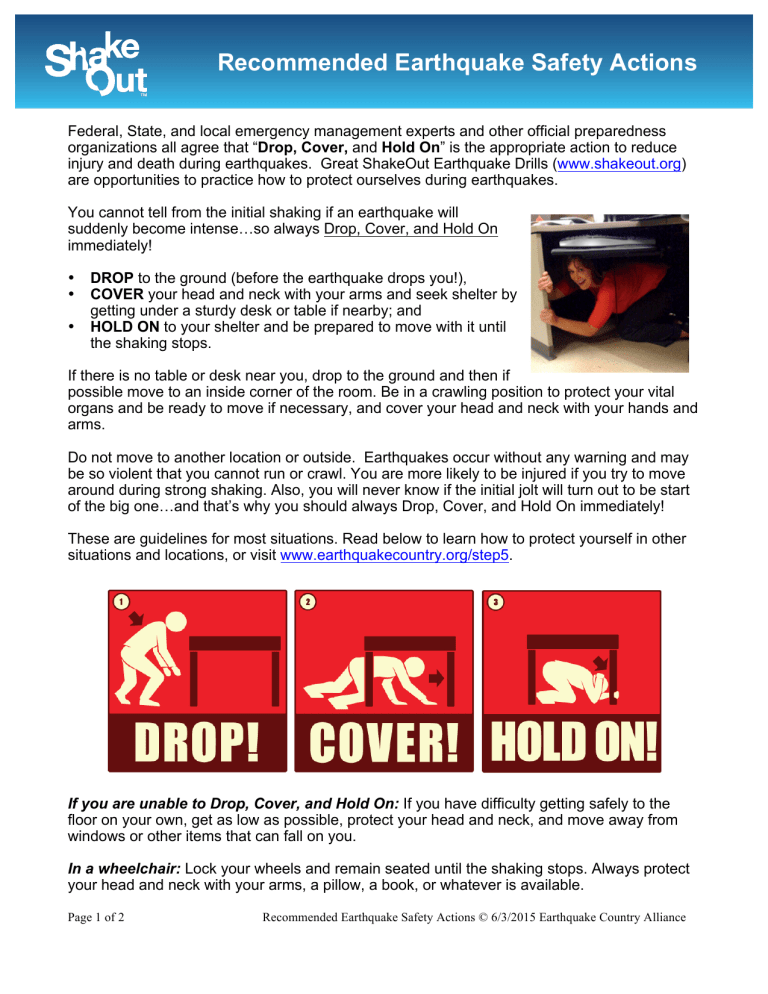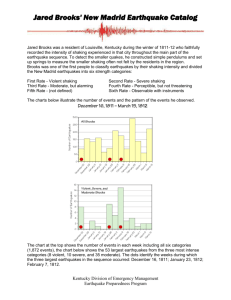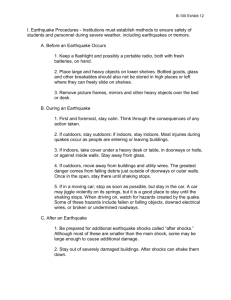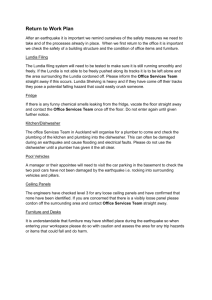Recommended Earthquake Safety Actions

Recommended Earthquake Safety Actions
Federal, State, and local emergency management experts and other official preparedness organizations all agree that “ Drop, Cover, and Hold On ” is the appropriate action to reduce injury and death during earthquakes. Great ShakeOut Earthquake Drills ( www.shakeout.org
) are opportunities to practice how to protect ourselves during earthquakes.
You cannot tell from the initial shaking if an earthquake will suddenly become intense … so always Drop, Cover, and Hold On immediately!
•
DROP to the ground (before the earthquake drops you!),
• COVER your head and neck with your arms and seek shelter by getting under a sturdy desk or table if nearby; and
•
HOLD ON to your shelter and be prepared to move with it until the shaking stops.
If there is no table or desk near you, drop to the ground and then if possible move to an inside corner of the room. Be in a crawling position to protect your vital organs and be ready to move if necessary, and cover your head and neck with your hands and arms.
Do not move to another location or outside. Earthquakes occur without any warning and may be so violent that you cannot run or crawl. You are more likely to be injured if you try to move around during strong shaking. Also, you will never know if the initial jolt will turn out to be start of the big one … and that’s why you should always Drop, Cover, and Hold On immediately!
These are guidelines for most situations. Read below to learn how to protect yourself in other situations and locations, or visit www.earthquakecountry.org/step5 .
If you are unable to Drop, Cover, and Hold On: If you have difficulty getting safely to the floor on your own, get as low as possible, protect your head and neck, and move away from windows or other items that can fall on you.
In a wheelchair: Lock your wheels and remain seated until the shaking stops. Always protect your head and neck with your arms, a pillow, a book, or whatever is available.
Page 1 of 2 Recommended Earthquake Safety Actions © 6/3/2015 Earthquake Country Alliance
Recommended Earthquake Safety Actions
In bed: If you are in bed, hold on and stay there, protecting your head with a pillow. You are less likely to be injured staying where you are. Broken glass on the floor has caused injury to those who have rolled to the floor or tried to get to doorways.
In a high-rise: Drop, Cover, and Hold On.
Avoid windows and other hazards. Do not use elevators. Do not be surprised if sprinkler systems or fire alarms activate.
In a stadium or theater: Stay at your seat or drop to the floor between rows and protect your head and neck with your arms. Don’t try to leave until the shaking is over.
Then walk out slowly watching for anything that could fall in the aftershocks.
MYTH – Head for the
Doorway:
An enduring earthquake image of California is a collapsed adobe home with the doorframe as the only standing part. From this came our belief that a doorway is the safest place to be during an earthquake.
We now understand that doorways are no stronger than any other part of the
In a store: When Shaking starts, Drop Cover and Hold
On. A shopping cart or getting inside clothing racks can provide some protection. If you must move to get away house, and do not provide protection from falling or flying objects. You are safer under a table. from heavy items on high shelves, drop to the ground first and crawl only the shortest distance necessary. Whenever you enter any retail store, take a moment to look around: What is above and around you that could move or fall during an earthquake? Then use your best judgment to stay safe.
Outdoors : Move to a clear area if you can safely do so; avoid power lines, trees, signs, buildings, vehicles, and other hazards.
Driving: Pull over to the side of the road, stop, and set the parking brake. Avoid overpasses, bridges, power lines, signs and other hazards. Stay inside the vehicle until the shaking is over.
If a power line falls on the car, stay inside until a trained person removes the wire.
Near the shore: Drop, Cover, and Hold On until the shaking stops. If severe shaking lasts twenty seconds or more, immediately evacuate to high ground as a tsunami might have been generated by the earthquake. Move inland two miles or to land that is at least 100 feet above sea level immediately. Don’t wait for officials to issue a warning. Walk quickly, rather than drive, to avoid traffic, debris and other hazards.
Below a dam: Dams can fail during a major earthquake. Catastrophic failure is unlikely, but if you live downstream from a dam, you should know flood-zone information and have prepared an evacuation plan.
More information: www.shakeout.org
www.dropcoverholdon.org
www.earthquakecountry.org/step5 www.earthquakecountry.org/dropcoverholdon
Page 2 of 2 Recommended Earthquake Safety Actions © 6/3/2015 Earthquake Country Alliance








